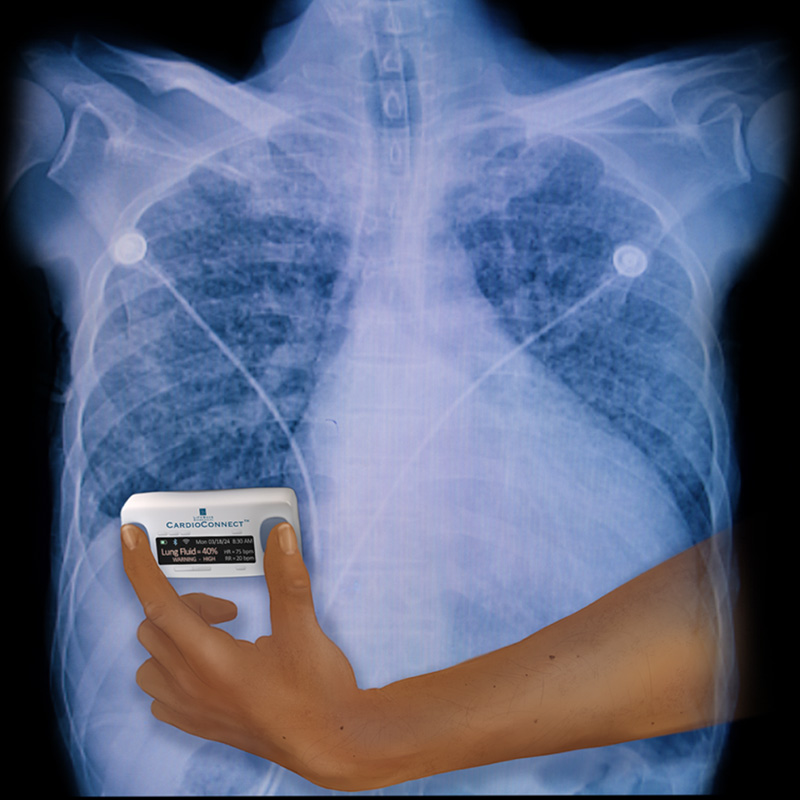Ultra-Wideband (UWB) Medical Radar Technology

Current cardiopulmonary diagnosis and monitoring systems typically rely on ECG, ultrasound, or invasive technologies to collect data. These technologies are well suited to data collection in the clinical environment or when patient mobility is limited. However, none of them are practical for long term monitoring of an individual, particularly outside the clinical environment.
Since ECG-based systems measure the electric fields associated with cardiac activity, ECG is unable to provide mechanical, functional or respiratory assessments. ECG requires direct skin contact and can suffer from a number of problems including skin-lead separation, muscle action potential interference, and electromagnetic interference (EMI). Though ECG machines are used in a variety of environments, including hospitals, physician’s offices, and homes, their use outside the hospital environment is typically limited to relatively short studies lasting less than 48 hours.
Like ECG, ultrasound also requires direct skin contact with the added inconvenience of requiring acoustically conductive gels. Ultrasound equipment is relatively large and requires a skilled sonographer to operate, limiting its applicability to the clinical environment. Catheter systems are invasive, expensive, require great skill to use and have a high rate of complications, significantly limiting their applicability. Each of the above referenced technologies, while capable of providing good data, are poorly suited for expanded non-clinical use.
LifeWave’s UWB medical radar sensor is able to collect a variety of physiological data that are currently unavailable or impractical to collect in the ambulatory and clinical setting. UWB medical radar is an active imaging technology similar in functional concept to ultrasound but is based on electromagnetic, rather than sonic energy. In practice, the sensor emits a microburst of RF energy which propagates into the human body. As the energy enters the body, small amounts of the incident energy are reflected back to the device. The reflected energy is then processed using patent pending signal processing techniques to extract information on the type, location, size, and relative movement of the underlying tissues and organs. LifeWave’s sensors are able to measure advanced physiological functions quickly, easily, safely, and at a reduced cost without requiring skin contact, conductive gels, electrodes, or leads.
In a number of animal and human research trials, a single LifeWave sensor has demonstrated the ability to accurately measure a number of critical cardiopulmonary parameters, including cardiac rate, relative stroke volume, changes in blood pressure, and cardiac output, pulmonary rate and relative end tidal volume. Additionally, it has been used to track and validate the effectiveness of defibrillation during ventricular fibrillation.
LifeWave has developed the UWB medical radar sensor and associated algorithms specifically targeting medical applications. The LifeWave UWB medical radar sensor is composed of an UWB transceiver (a transmitter and receiver) connected to an embedded processor. The processor is responsible for controlling the transceiver, collecting the digitized reflection data, extracting the desired physiological information and transferring this distilled data to a medical information system.
The physical principles behind the UWB medical radar sensor are identical to those of traditional radar. The UWB medical radar sensor transmits extremely short duration bursts of electromagnetic energy on the order of hundreds of picoseconds in duration. The short pulse duration enables examination of close-in targets and extremely fine radial resolution because the resultant transmitted frequency spectrum is extremely broadband with low average power. This spectrum resembles uncorrelated background noise, minimizing the potential of interfering with other electronic devices and systems.
When these pulses are pointed in the direction of interest – in this case, the thoracic region of the human body, the anatomical structures in its path will be illuminated by the RF energy. A portion of the incident energy is reflected which the radar receives and processes, extracting information on the illuminated structures.
Electromagnetic reflections occur when an electromagnetic wave exits a material of one distinct electrical property and enters another material of a different electrical property. The body is a complex structure, consisting of a variety of biological materials, each possessing different dielectrics properties.
LifeWave Biomedical, Inc. has successfully participated in several government sponsored research projects investigating both medical and non-medical applications of the UWB radar technology. These projects have allowed LifeWave to advance the state of the technology and explore various applications while building a strong competency in the clinical and field environment while building the company’s intellectual property, through which LifeWave has obtained a number of issued USPTO patents.
U.S. Government Funded Research
- Cardiac and Respiratory Biometric Data – Walter Reed Army Institute of Research
- Relative Cardiac Stroke Volume – U.S. Army Institute of Surgical Research
- Relative Blood Pressure and CPR ROSC – NIH National Heart, Lung, and Blood Institute
- Human Subject Thru-Wall Detection & Movement Tracking (1 ft. Concrete Wall) – Office of Naval Research
